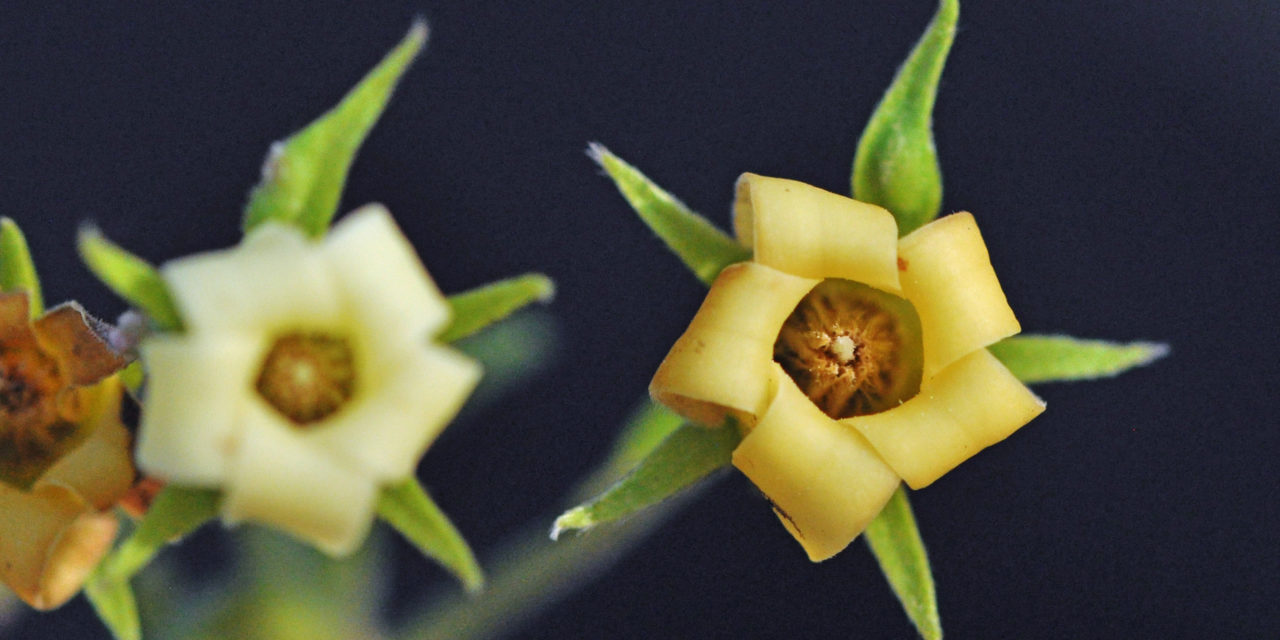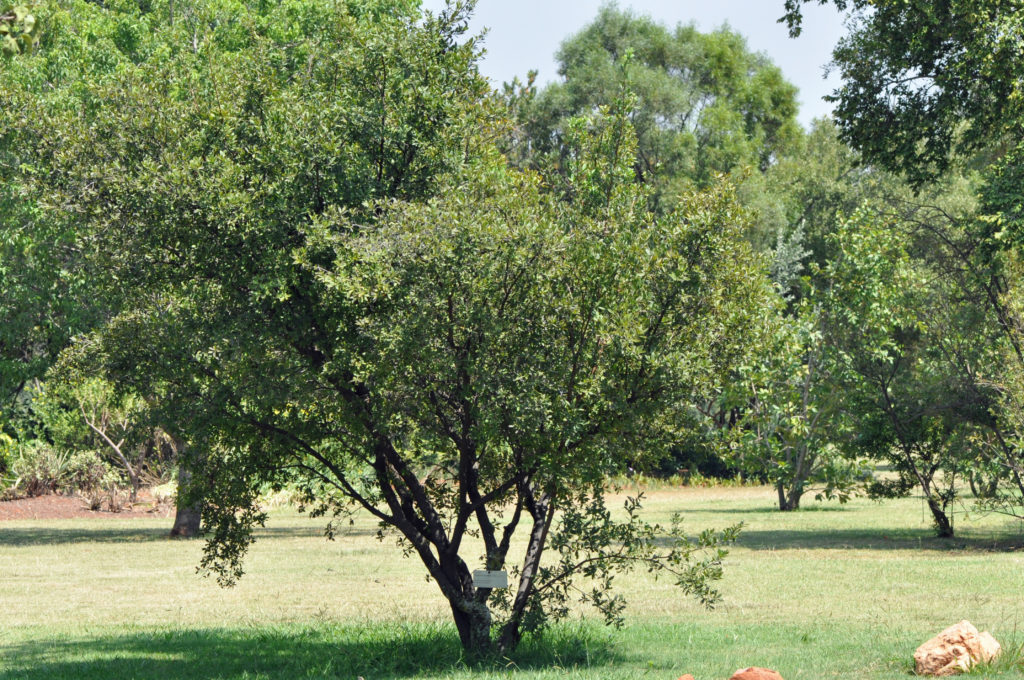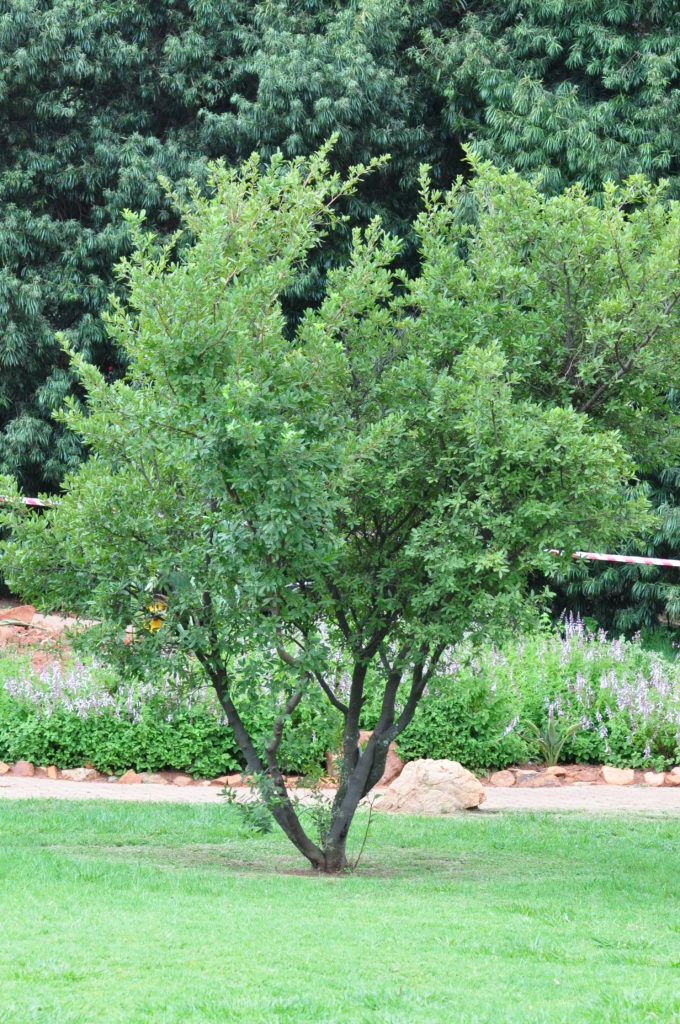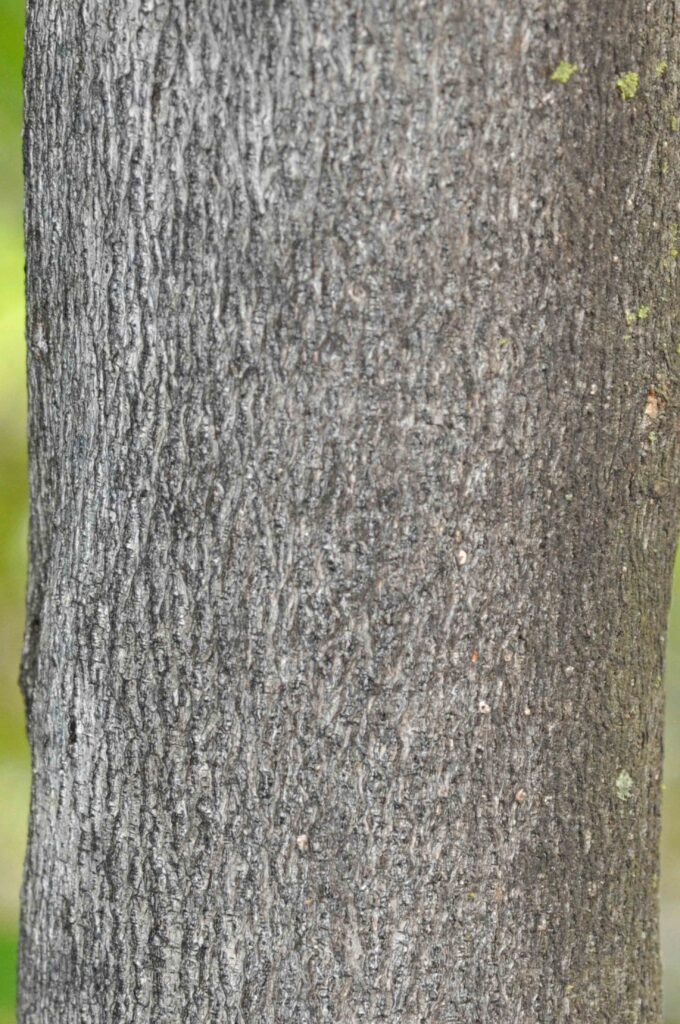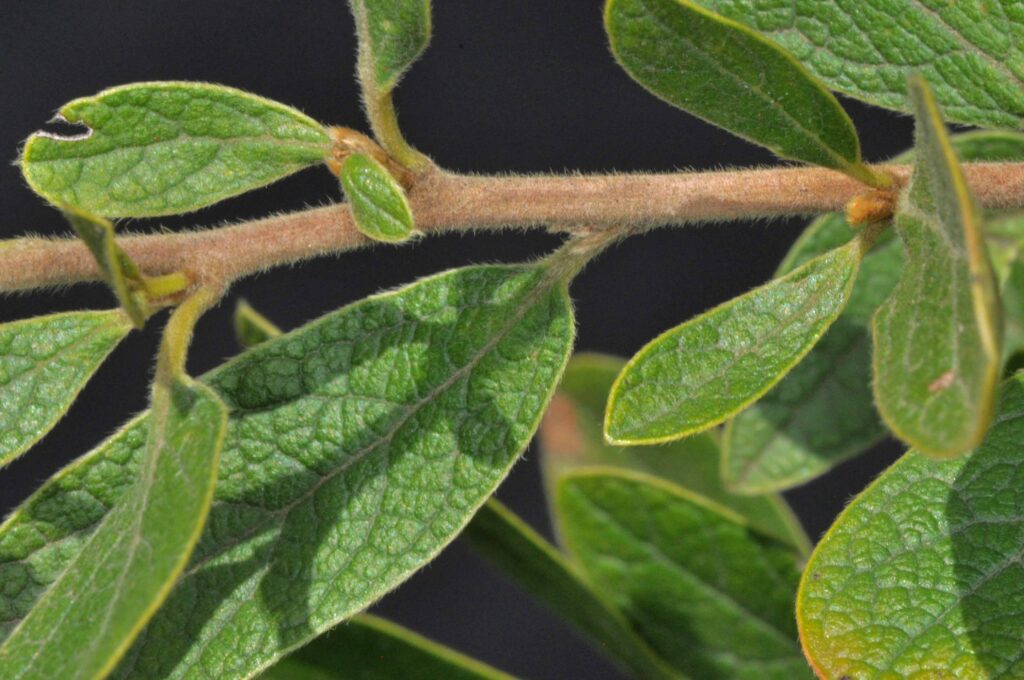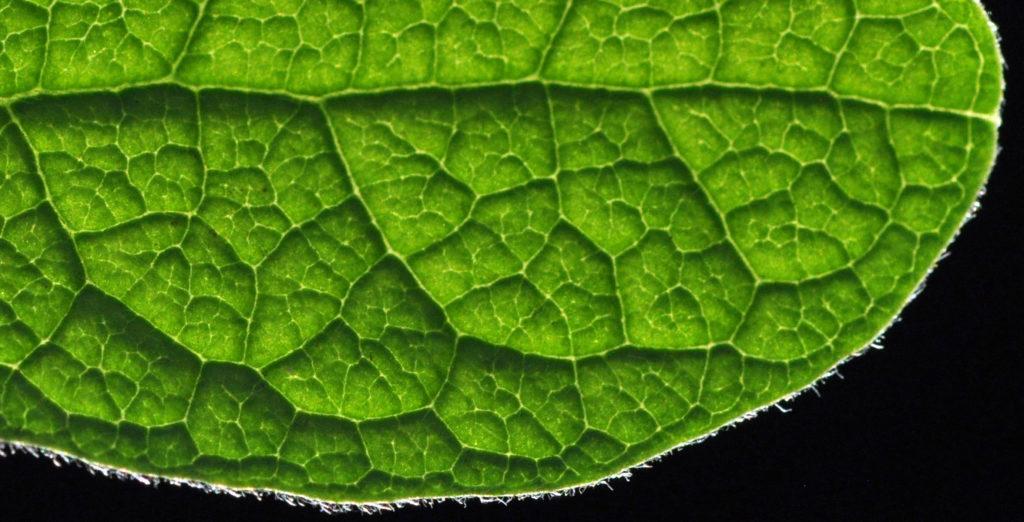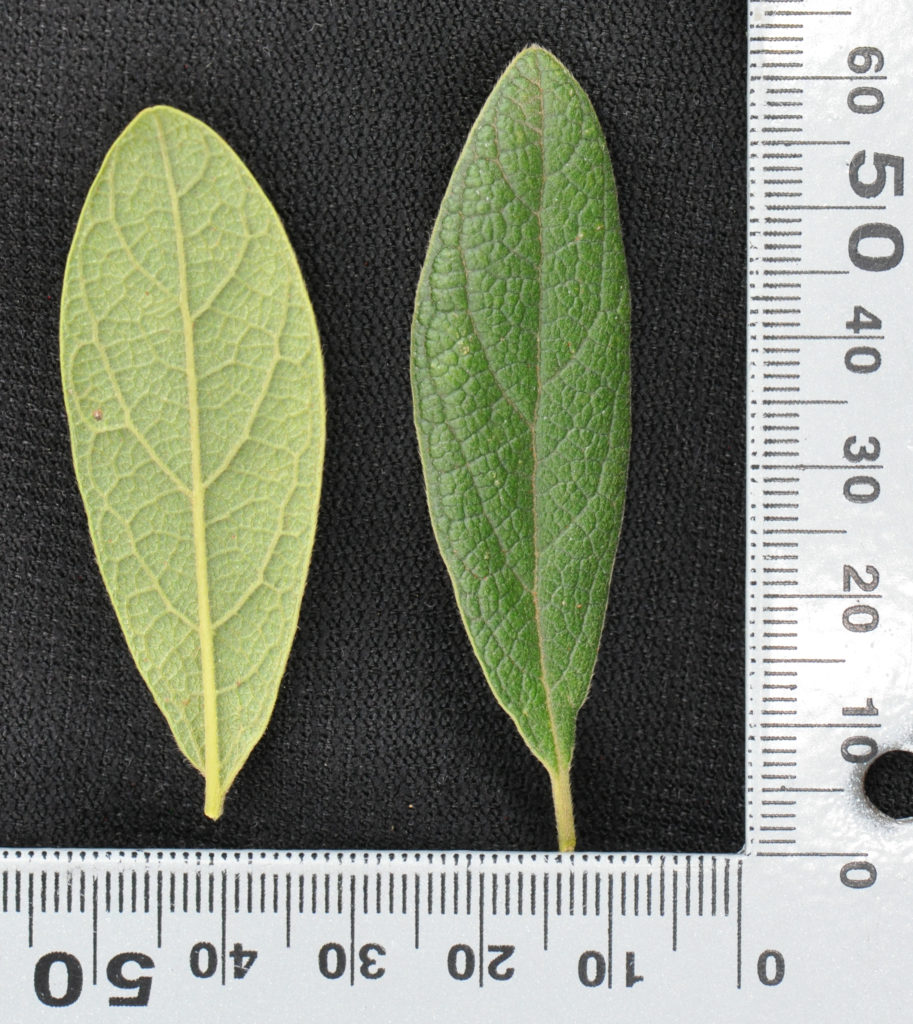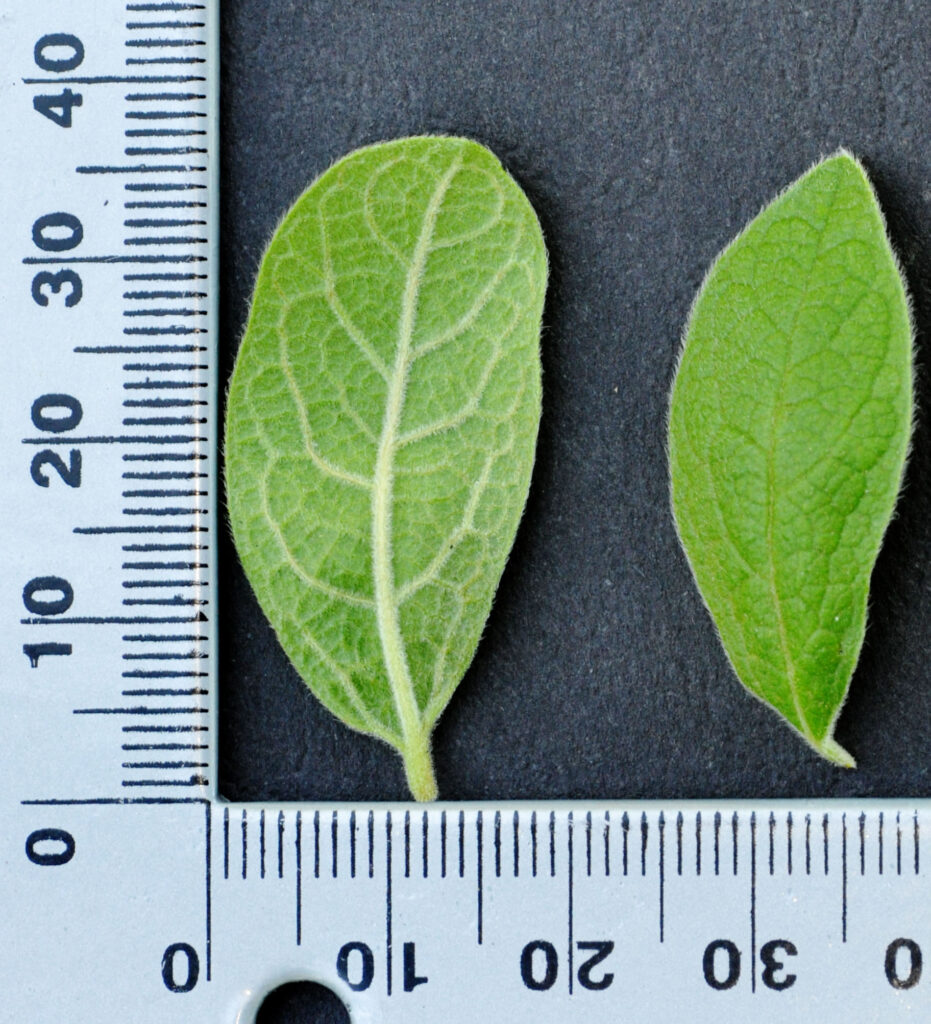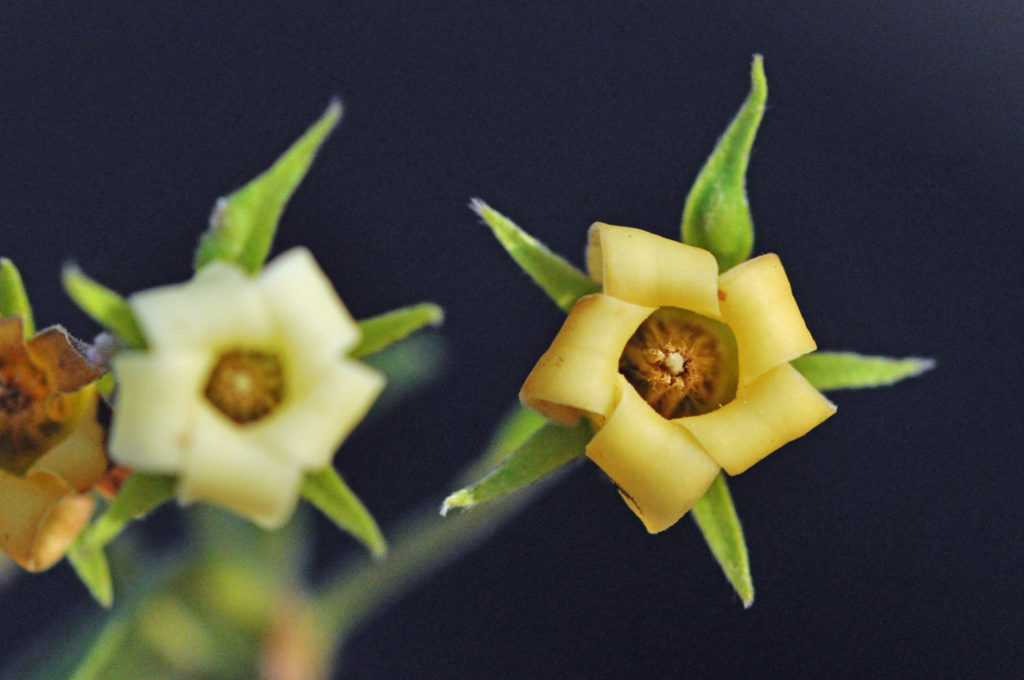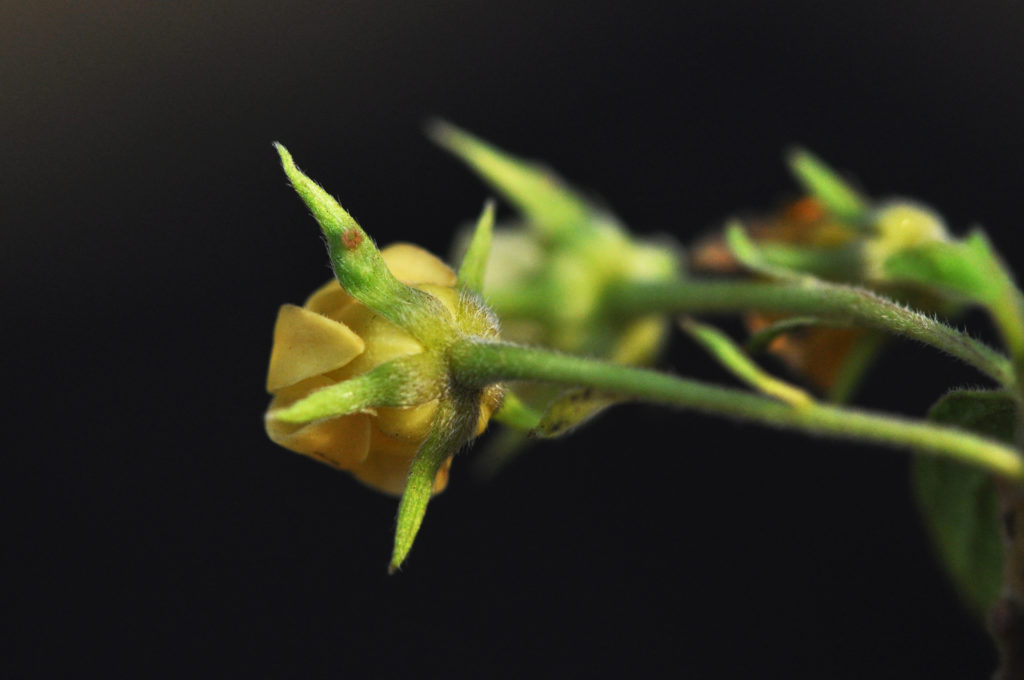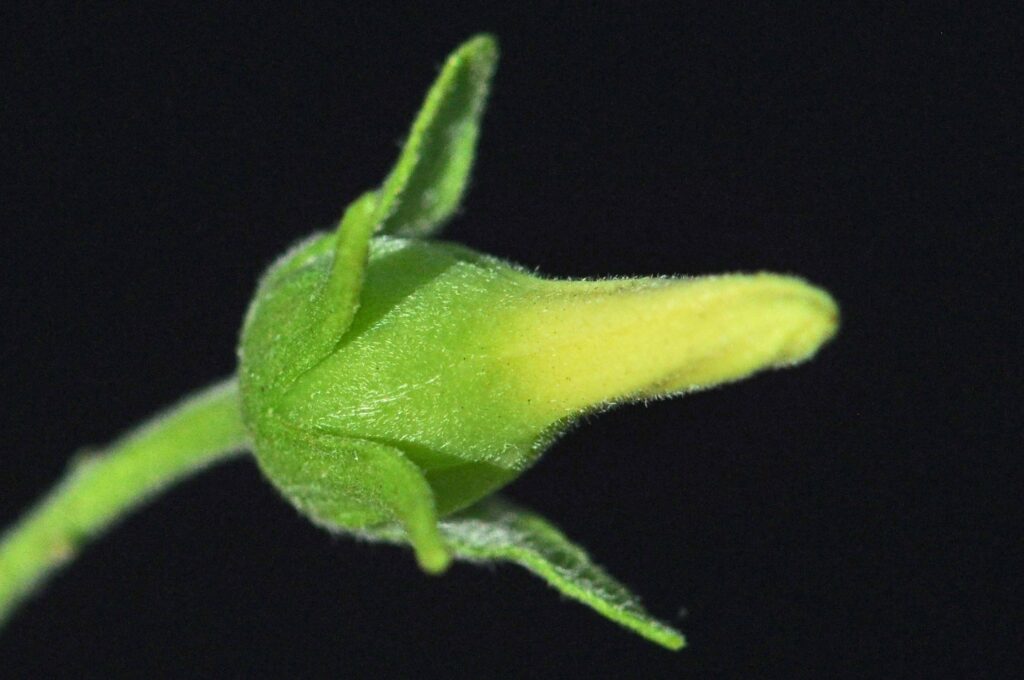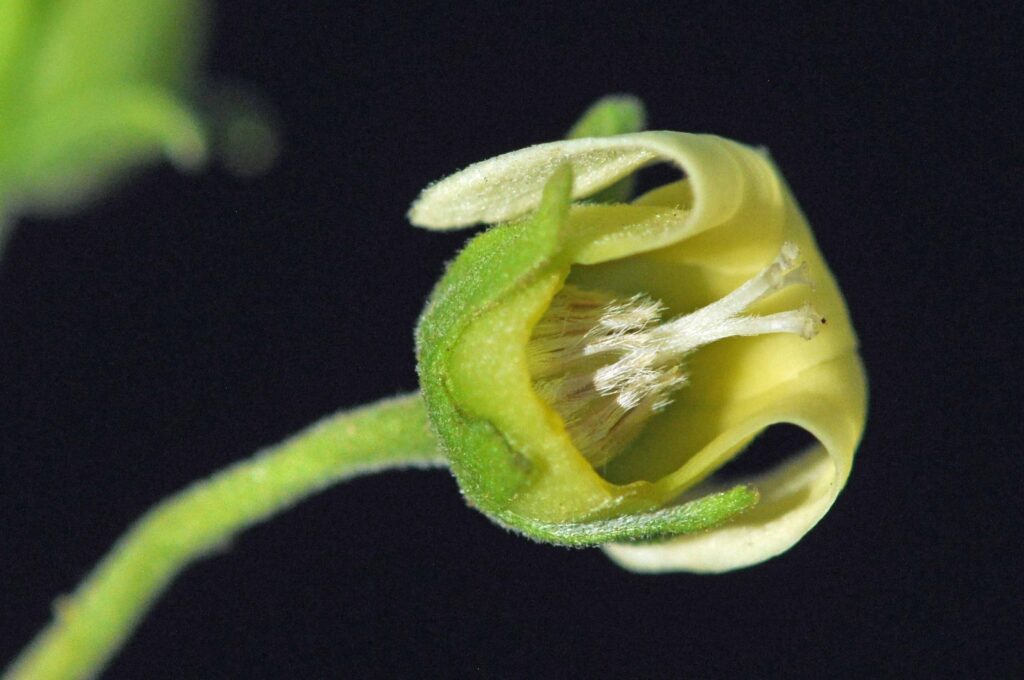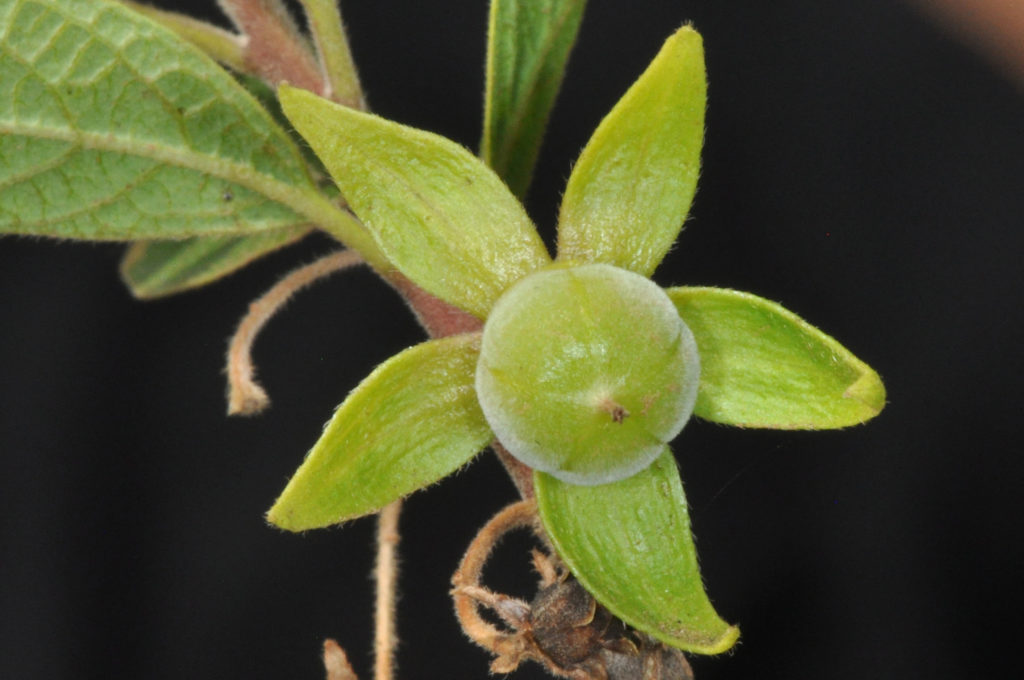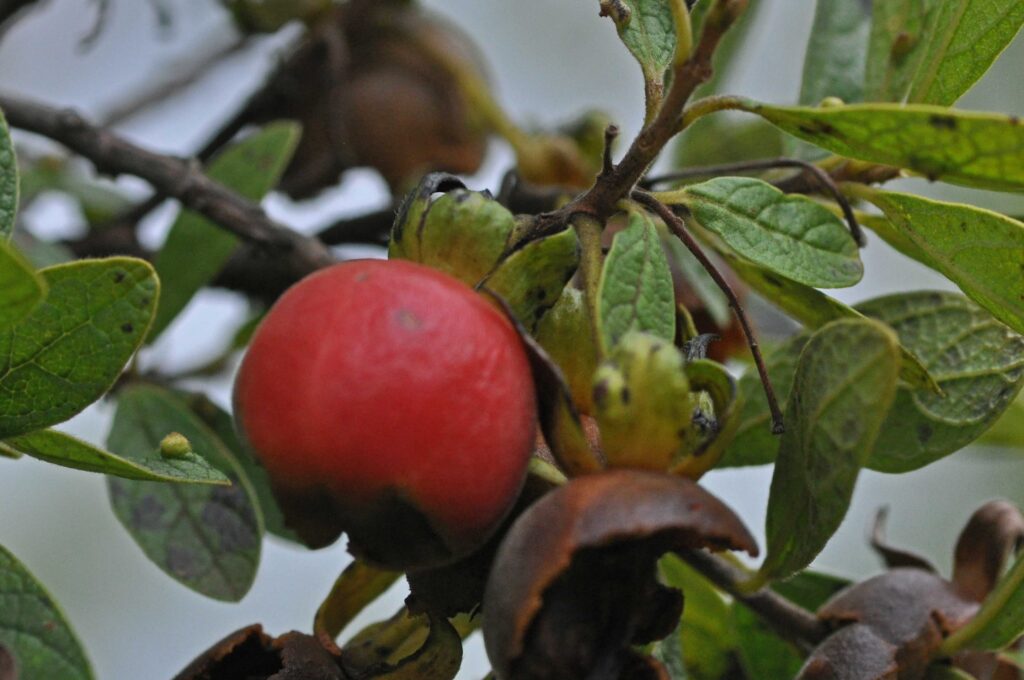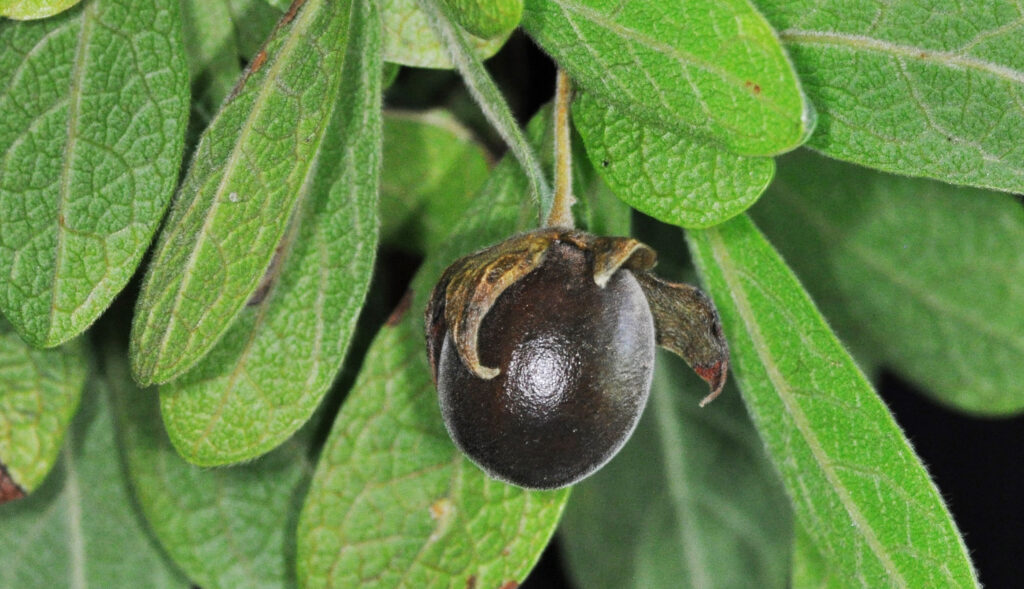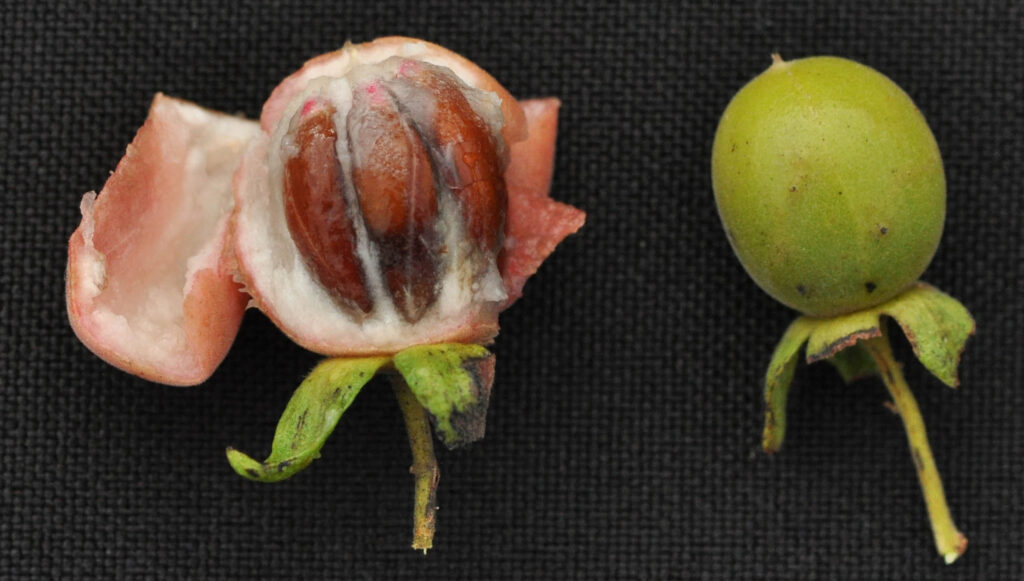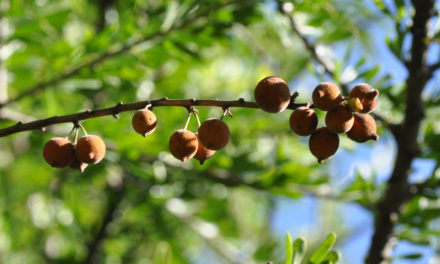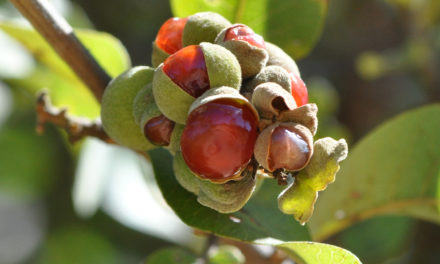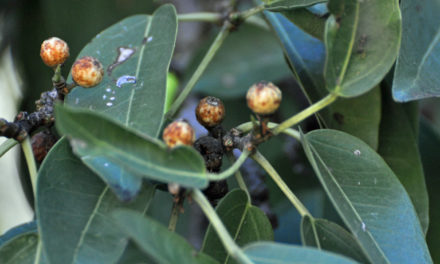General Info – summary
This shortish Tree has a smooth bark. It may also be a shrub. Milky sap & thorns are absent. The spirally arranged, leathery, hairy Leaves are simple & rest on a short petiole. The solitary creamy white to yellow actinomorphic and 5-merous Flowers are functionally unisexual. Male flowers have 10 stamens & females have 5 styles. Fruit is a berry with a persistent accrescent calyx. Up to 6 smooth seeds are produced.
Description
Diospyros lycioides
Previous Names: Royena guerkei, Royena lycioides subsp. guerkie.
SA Tree No. 605, 605,1 and 605.2.
Common names: (Afr) Bessieboom, Hoeveldbloubos, Jakkalsbessie, Bloubos. (Eng) Bluebush, Bluebush Star-apple, Quilted Bluebush, Red Star-apple, Star apple, Transvaal Bluebush. (isiZulu) Umnqandane. (Northern Sotho) Mohladyane, Motloumana. (Setswana) Lethatsa. (siSwati) Mcafutane, Umcafudane. (Tshivenda) Muthala.
Family: Ebenaceae (persimmon and ebony family). The family has some plants known for the useful wood and others for fruit. Trees are usually located in tropical and warmer temperate regions. There are more than 750 species, in 4 genera, worldwide and the 37 species in South Africa occur in 2 genera (Euclea and Diospyros). The bark and heartwood are black. The simple, coriaceous and entire Leaves lack stipules are usually alternate or may be opposite, but both may occur on the same plant. The usually unisexual and regular Flowers have a persistent calyx that is often divided near to the base. The corolla usually has a short tube, with petals fused at the base and extend with overlapping lobes. The basifixed anthers are longer than the filaments. The superior ovary has up to 2 ovules in each locule. The styles may have 2-5 branches. Fruit is a berry with an accrescent calyx, which may dehisce slowly. Young fruit contains tannins and are usually avoided by animals until ripe.
Name derivation: Diospyros: Dios – divine; pyros – pear (referring to the flavour of some fruits). lycioides referring to the likeness of a member of the potato family: Salonaceae.
There are in excess of 700 species in the genus Diospyros Worldwide. These species are tropical and subtropical and usually dioecious (unisexual floral structures with male and female parts are on separate plants). The valued timber trees are called ebony trees and produce dense, hard and dark timber. Trees valued for their fruit are called persimmon trees. Neither ebony nor persimmon are indigenous in South Africa. Here there are about 18 species of the genus Diospyros and a number of verities and subspecies in the genus.
Conservation: National Status: L C. (Least Concern). Assessment: 2005 (W. Foden and L. Potter).
Tree
The main Stem (or trunk is main axis of the plant, the leaf and flower bearing as distinguished from the root-bearing axis) is usually multi stemmed (photo 180) or single stemmed. The tree is densely branched with a dense crown. The Tree is usually up to 3m high but may reach 8m. The dark grey Bark is relatively smooth (photo 209). Branches tend to grow upright. Young stems are often hairy (photo 347 – under Leaves). No milky sap or thorns are present.
- 180. 2018/03.14 Pretoria NBG. Photo. David Becking. subsp. guerkei.
- 342. 2016/01/26 Pretoria NBG. Photo. David Becking. subsp. guerkeii.
- 209. 2014/10/21 Walter Sisulu NBG. Photo. David Becking. subsp. guerkei.
Leaves
The smallish, leathery, blue-green or dull grey-green and spirally arranged Leaves (photo 347) are crowded at the ends of short branches. Leaves may reach 8 x 3cm – usually smaller and are simple (have a single blade, which may have incisions that are not deep enough to divide the blade into leaflets – photo 208). Depending on the weather, the plant may be deciduous. Leaves are elliptic, obovate (upside-down egg-shaped) or oblanceolate, (the leaf is broader at the apical third than at the middle and tapers towards the base). Leaves may be hairy especially below and over the Veins. The amount of hair decreases with time (a human trait?). The Midrib has 5-6 pairs of lateral veins, which are visible and often prominent. The Apex is broadly tapering to rounded (photo 208). The tapering Base may be asymmetric (photo 344) and is partly rolled under. The Margin is hairy – at least when young (photo 590), and entire (with a continuous margin, not in any way indented – photo 344). The distinct but short Petiole (leaf stalk) is 3 to 15mm long. Veins may be raised below and sunken above (photo 208). The patterned net veining is best observed when the leaf is held against a strong light (photo 590). From this vantage point, the hairs on the margin may visible. In the field, a hand lens would help.
There are four subspecies of D. lycioides, which differ mainly in leaf appearance and distribution:
Subsp. guerkei. The Leaves are up to 5 x 2cm with distinctly patterned net-veins. The net veins are indented above and raised below. Some spreading hairs may be present or leaves are hairless.
Subsp. lycioides. The Leaves are up to 4 x 1,5cm, smooth or slightly velvety and lateral veins are not raised. Both leaf surfaces may be slightly hairy but are usually hairless and smooth.
Subsp. nitens. The smaller leaves are up to 2 x 1cm and covered with dense, silvery hairs.
Subsp. sericea. The Leaves up to 8 x 3cm and usually densely covered with silky hairs. On the lower leaf surface of larger leaves, the midrib is raised but, but the lateral veins are only slightly raised.
- 347. 2016/01/26 Pretoria NBG. Photo. David Becking. subsp. guerkei.
- 590. 2019/09/18 Walter Sisulu NBG. Photo. David Becking. subsp. guerkei.
- 344. 2016/01/26 Pretoria NBG. Photo. David Becking. subsp. guerkei.
- 208. 2018/05/24 Walter Sisulu NBG. Photo. David Becking. subsp. guerkei.
Flowers
The pendulous, solitary, bell shaped, creamy white to yellow Flowers are functionally unisexual floral structures with critical male and female parts in separate flowers. They are located in leaf axils. Individual flowers are small, up to 15mm in diameter and 8mm long. The sweetly scented flowers – especially at night are actinomorphic (Regular, symmetrical. Flowers are vertically divisible into similar halves by more than 1 plane passing through the axis). Each flowers is supported by a hairy, relatively long Pedicle (stalk of a single flower) which may reach 3cm long (photo 283). The hairy Calyx has 5 thin, conspicuous, long, deeply divided Sepals which are persistent and become partly reflexed (photo 283). The Corolla is up to 1cm long. It has a swollen middle, narrowing apex, is urn-shaped (photo 581), and contains 5 Petals with united bases. The throat is widely opened, and the petal lobes overlap and reflex as they open (photo 284). In the Male flowers, there are 10 Stamens, each about 4mm long. The Filaments are shorter than the basifixed Anthers. There is a short Style, which lacks a stigma. The Female flowers (photo 585) have a single Pistil (a unit of the Gynoecium, the female element of the flower, composed of the Ovary, Style and Stigma) situated on a hairless, somewhat fleshy Disc (a more or less fleshy or elevated development of the receptacle). In photo 585, the infertile male parts with bristle covered Staminodes (sterile stamens) are clearly visible. Here the Ovary is superior and has 5 Stigmas ending in Styles. (Aug-Dec).
- 284. 2017/10/02 Pretoria NBG. Photo. David Becking. subsp. guerkei.
- 283M. 2017/10/02 Pretoria NBG. Photo. David Becking. subsp. guerkei.
- 581. 2018/09//18. Walter Sisulu NBG. Photo David Becking. subsp. guerkei.
- 585. 2018.09/18. Walter Sisulu NBG. Photo David Becking. Dissected. subsp. guerkei.
Fruit
The soft and hairy young Fruit is a Berry (pulpy, indehiscent fruit like a grape or tomato) with a jelly like flesh. It is almost spherical or oval in outline. The fruit is up to 2cm long. It is initially green (photo 30) turns an attractive red (photo 659), then light brown to black and is hard when mature (photo 317). During this process, all hairs are lost. The fruit closely resemble a miniature persimmon. The 5 persistent Calyx lobes are initially green and become accrescent (continue to grow after flowering – photo 25). They become folded back and each fruit is eventually up to 1,5cm long (photo 25). A persistent style may be visible on the young fruit (photo 700). The mature fruit dehisces slowly, and old fruit may remain on the tree until at least the next flowering season. Up to 6 smooth brown Seeds are produced. Each is up to 1,3cm long, and a nearly straight-line groove is present (photo 700). (Jan–May).
- 25. 2016.10.18 Pretoria NBG. Photo. David Becking. subsp. guerkei.
- 659. 2018/01/30 Pretoria NBG. Photo. David Becking. subsp. guerkei.
- 317. 2015/12/22 Walter Sisulu NBG. Photo. David Becking. subsp. guerkei.
- 700RR. 2020/01/20. Walter Sisulu NBG. Photo. David Becking. subsp. guerkei.
Distribution & Ecology
The distribution is very wide. It is common in grassland, forest margins and in rocky areas. This is also a pioneer plant (are hardy species that are the first to colonize new or previously disturbed areas). The larvae of the Mooi River Opal butterfly (Chrysoritis lycegenes) feed on the Leaves and those of Myrsine africana as well as Searsia spp. The leaves may be mildly poisonous at times. The Flowers attract many insects, including bees and, consequently, many birds. Rock dassies or rock hyrax (Procavia capensis – the closest living relative to the African elephant despite being rabbit sized), monkeys and Pied Starlings consume the Fruit. The fruit contains tannins and is usually avoided by animals until the fruit is ripe and the tannin level decrease. Birds that consume the ripe fruit help with dispersal of seeds.
There are four subspecies of D. lycioides, which differ mainly in leaf appearance and distribution:
Subsp. guerkei. Location is in rocky habitats and often associated with outcrops of quartzite (rock composed almost entirely of quartz. It is non-foliated and usually forms from the metamorphosis of sandstone). These plants usually occur to the north of the Vaal River. In SA, the plant is found in Gauteng e.g., Melville Koppies Nature Reserve where over 40 indigenous trees can be seen), KwaZulu-Natal, Limpopo, Mpumalanga, and North West. Beyond SA, it occurs in Swaziland and Mozambique.
Subsp. lycioides. Location is widespread within the summer rainfall region (i.e., excluding the SW Cape Province – winter rainfall area). Beyond South Africa, they occur in Swaziland, Zimbabwe, Botswana, and Namibia. The plants are more numerous in drier areas.
Subsp. nitens. Location in grasslands and rocky outcrops from Polokwane (Pietersburg) in Limpopo southwards to western KwaZulu-Natal.
Subsp. sericea. Location in grasslands and rocky outcrops from Polokwane (Pietersburg) in Limpopo southwards to western KwaZulu-Natal. Location is mainly sub-tropical distribution – including the eastern parts of South Africa: Eastern Cape, KwaZulu-Natal, Mpumalanga and northwards to Zimbabwe.
Ethnobotany
The Wood is strong but relatively thin. Heartwood is brownish pink and sapwood is lighter. The wood sands and polishes well. It has been used to make spoons, build huts and for fuel. Roots and twigs are used as toothbrushes. They contain antibacterial compounds against oral pathogens. Roots are very strong and can cause problems with ploughs. They also provide a yellowish dye. The tree is a good honey plant. Ground seeds have been used as a substitute for coffee. Ripe Fruits are edible and sweet tasting. However, a report suggests that the fruit may be slightly poisonous. Fruit can be used to make alcoholic drinks – including beer. Planted trees will attract birds. To obtain fruit, both male and female trees must be planted – preferably in full sun. Water the trees regularly. This wind and cold hardy plant has been used for Bonsai. Trees take 4 or more years to flower.
References
Boon, R. 2010. Pooley’s Trees of Eastern South Africa. Flora and Fauna Publications Trust, Durban.
Burrows, J.E., Burrows, S.M., Lotter, M.C. & Schmidt, E. 2018. Trees and Shrubs Mozambique. Publishing Print Matters (Pty) Ltd. Noordhoek, Cape Town.
Coates Palgrave, M. 2002. Keith Coates Palgrave Trees of Southern Africa, edn 3. Struik, Cape Town.
Foden, W. & Potter, L. 2005. Diospyros lycioides Desf. subsp. guerkei (Kuntze) De Winter. National Assessment: Red List of South African Plants version 2020.1. Accessed on 2023/02/14.
Lawrence, G. H. M, 1951. Taxonomy of Vascular Plants, The Macmillan Company, New York. Tenth Printing 1965.
Palmer, E. & Pitman, N. 1972. Trees of southern Africa, Balkema, Amsterdam, Cape Town.
Schmidt, S. Lotter, M. & McCleland, W. 2002. Trees and Shrubs of Mpumalanga and the Kruger National Park.
van Wyk, B. & van Wyk, P. 1997 Field guide to Trees of Southern Africa, Struik, Cape Town.
http://www.plantzafrica.com/plantcd/diospyroslyc.htm
http://witkoppenwildflower.co.za/diospyros-lycioides-subsp-guerkei/
https://scholar.sun.ac.za/handle/10019.1/72654
http://www.prota4u.org/protav8.asp?p=Diospyros+lycioides good.
https://en.wikipedia.org/wiki/Ebenaceae
http://posa.sanbi.org/flora/browse.php?src=SP

